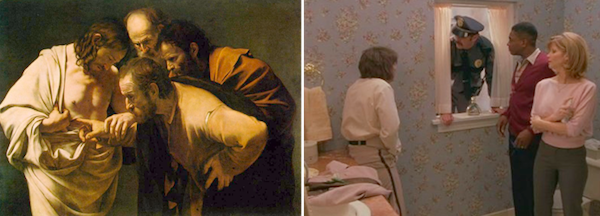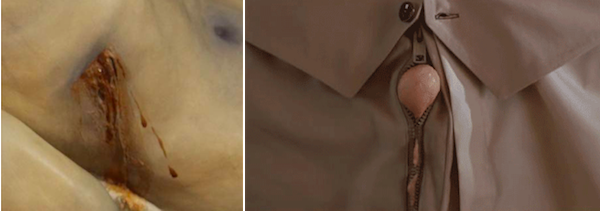Film
Some things about Mary

Caravaggio’s The Incredulity of Saint Thomas (c. 1602), known colloquially as “Doubting Thomas,” shows the titular Apostle incredulously putting said incredulity to rest upon sticking his finger inside Jesus’ wound after his resurrection (whose phonetic ties to “erection” may be our first mouthful of phallicy). Jesus says, “Blessed are those who have not yet seen and yet have believed,” a somewhat snarky comment directed at the proof contingency of Thomas. God, a prick in my book, denies the Virgin Mary any clitoral or vaginal stimulation, deferring to the “divine agency” of his bodiless baby batter. Anal seemed out of the question as well. Their son Jesus is likewise denied carnal knowledge with his own Mary (Magdelene), our codependent threesome the world’s first dysfunctional family. I’ve always found Jesus’ loin cloth a sunken concavity, almost tucked-in in trying perhaps to be a daughter. Emasculate comes from the latin emasculare, meaning castrate, fortunately used in a figurative sense. Ben Stiller’s comedic and dramatic qualms in Meet the Parents, Reality Bites, Greenberg, and There’s Something About Mary all tell the story of a dude’s trouble either getting or holding on to the girl. It’s bro humor, but not of sexual entitlement, rather, feminine-like worry and desire for love. Zoolander may even have a touch of peer misandry, and I find Stiller’s work “cutting edge” when it comes to chronic castration anxiety. Back in Rhode Island, in which most Farrelly brothers films are set, Mary’s mother and step-father, along with a doubting cop, cannot believe what Ted Stroehmann did to his “frank” and “beans” until they see it. Here the Farrelly brothers cut to the proof, in the unedited version at least.

The fifth of the Five Holy Wounds is a lance’s puncture in the side of Jesus’ chest, right under his fuck buddy yielding ribs. Before porn — perhaps in place of sexuality, or at least the incipient development of its aesthetics — we had only the swollen dripping labia of Jesus’ holes, always painted with creepy fascination. Female genitalia as a wound. J.G. Ballard may have borrowed from this idea in Crash (1973), in which characters fuck flesh wounds in car accidents. Jesus’ crucifixion could be likened to sexual abuse: being incapacitated, penetrated, and desecrated. The Bible oddly finds allegiance with women through His passion. What seems to be one of Ted’s testicles is a bulbous convex wound, a sack of hopeful progeny. Fast forward over the years and his baby batter now hangs off his ear, mistaken by Mary for hair gel. The hanging globule of splooge is much thicker than other depictions of semen in popular film (Silence of the Lambs, Happiness, American Pie, The Squid and the Whale), which seems in line with the dark perversity of the Farrelly brothers.
Mary Magdalene comforted Jesus in transit with the cross, and at the cross, long after His male disciples fled. It is unclear if she acted as someone in love, or simply out of love. Profane feelings and sacred commitments will often look the same on someone’s face, her’s ridden with the pathos of man, often chiseled with chiaroscuro’s binary of light and dark. Her complicated role in Jesus’ life has been reduced by doubtfuls to her simply being a whore, which is at once both arrogantly dismissive and a male fantasy. Virgin Mary is a conceptual breeder, the idea of a mother. It is Mary Magdalene who inherited the former’s maternal role, which may explain Momma’s boys’ unrealistic expectations of their partners. That His impossible mother and improbable lover shared the same name is so Oedipal they may as well be edible. Denied omnipresence, “Mary” becomes simultaneous: a mother, virgin, and whore. It is unclear if “marry” is a etymological corruption of Mary, though Mari is a “young wife” in Sanskrit. “The Assumption” is an ecclesiastical description of the Virgin Mary being taken into the heavens at the end of her earthly life; that this is ironically an assumption may be lost on some ecstatic believers.
Cameron Diaz’s performance as contemporary Mary is mild but adequate, for her true meaning lies not in her face, but in the faces of her many futile suitors. Creeps and weirdos hash it out in her apartment in the end, confessing to the stalkerish ways that led them there. The idea of love is a lonely thing that drives one to seek an idea of its completion. Men often define who a woman is, ring the doorbell to fuck it, and are unhappy with who opens the door. There’s Something About Mary is a sad movie about the thoughtlessness and underlining violence of male desire — symbolized as a thick load in bangs stiffly rendered into Hokusai’s wave. AMC played it back-to-back last night for its 15th year anniversary, and I was stunned by how much time had passed in my life. I’ve probably watched it two or three times each year, every year, in that accidental way when you’re lying on the couch in front of a TV, in a daily serialization of your life that skipped primetime and went straight to syndication. The movie ends with a happy ending that would never happen: Ted resigns to a nobler Magdalenian love, basically giving up and handing her off to Brett Favre, in awkward cameo. Ted cries like a girl, and the girl comes out. The credits role in a shrunken window as the movie begins again. Sartre said we are imprisoned by the very choices which make us free. I guess I’ve chosen to continue paying Comcast for cable, to try to find old manners in new ways. A palm reader would look at His bloody hand, a hole as tight as an ass, and erroneously give Him a future of near death. He’d arise a few days later with a book deal. People would here on out call his name in ecstasy and pain. In moments of sheer terror and complete boredom. I hope my palm reader is wrong too.

http://al.ly/qxA